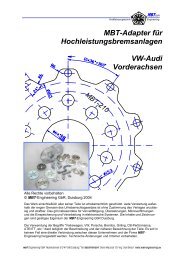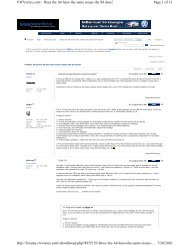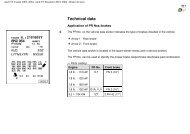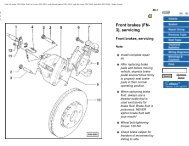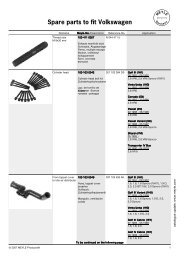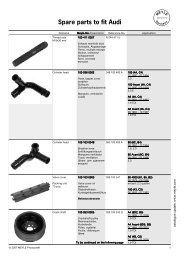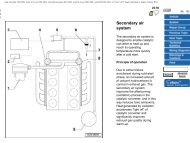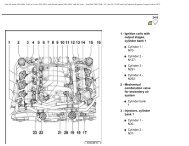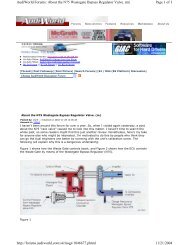VW MKII A2 MK2 Golf Jetta Fox Service Manual - VAGLinks.com
VW MKII A2 MK2 Golf Jetta Fox Service Manual - VAGLinks.com
VW MKII A2 MK2 Golf Jetta Fox Service Manual - VAGLinks.com
You also want an ePaper? Increase the reach of your titles
YUMPU automatically turns print PDFs into web optimized ePapers that Google loves.
6 Fluid leakage and engine<br />
electrical system check 1<br />
1 Open the bonnet and inspect the engine<br />
joint faces, gaskets and seals for any signs of<br />
coolant or oil leaks. Pay particular attention to<br />
the areas around the rocker cover, cylinder<br />
head, oil filter and sump joint faces. Bear in<br />
mind that over a period of time some very<br />
slight seepage from these areas is to be<br />
expected but what you are really looking for is<br />
any indication of a serious leak. Should a leak<br />
be found, renew the offending gasket or oil<br />
seal.<br />
2 Carefully check the condition and security<br />
of all under bonnet coolant, fuel, power<br />
steering and brake pipes and hoses. Renew<br />
any hose which is cracked, swollen or<br />
deteriorated. Cracks will show up better if the<br />
hose is squeezed. Pay close attention to the<br />
hose clips that secure the hoses to the system<br />
<strong>com</strong>ponents. Hose clips can pinch and<br />
puncture hoses, resulting in leaks. If wire type<br />
hose clips are used, it may be a good idea to<br />
replace them with screw-type clips (see<br />
Haynes Hint).<br />
A leak in the cooling system will usually<br />
show up as white or rust coloured<br />
deposits on the area adjoining the leak<br />
3 Check the condition of all exposed wiring<br />
harnesses. Ensure that all cable-ties are in<br />
place and in good condition. Ties which are<br />
broken or missing can lead to chafing of the<br />
wiring which could cause serious problems in<br />
the future.<br />
4 Wipe away any dirt which has accumulated<br />
on the outside of the alternator and check that<br />
its cable connector is pushed firmly onto its<br />
terminals.<br />
5 Clean the ignition system HT and LT leads<br />
by wiping along their length with a fuelmoistened<br />
cloth. Inspect each lead for<br />
damage and renew if defective in any way.<br />
Ensure that all lead connections are secure<br />
and where applicable, protected (see<br />
illustration).<br />
6 Check that all HT and LT leads are correctly<br />
routed and clear of moving or hot engine<br />
<strong>com</strong>ponents.<br />
7 Any corroded HT or LT lead connection<br />
Every 1000 miles or monthly 1•11<br />
6.5 Ensure all HT lead connections are<br />
secure<br />
must be cleaned. A smear of petroleum jelly<br />
(not grease) applied to the cleaned<br />
connection will help to prevent further<br />
corrosion.<br />
8 Check the transmission for obvious oil<br />
leaks and investigate and rectify any problems<br />
found.<br />
9 Where accessible, inspect the fuel filler<br />
neck for punctures, cracks and other damage.<br />
Sometimes a rubber filler neck or connecting<br />
hose will leak due to loose retaining clamps or<br />
deteriorated rubber.<br />
7 Battery electrolyte level<br />
check 2<br />
1 A “maintenance-free” (sealed for life)<br />
battery is standard equipment on all vehicles<br />
covered by this <strong>Manual</strong>. Although this type of<br />
battery has many advantages over the older<br />
refillable type and should never require the<br />
addition of distilled water, it should still be<br />
routinely checked. The electrolyte level can be<br />
seen through the battery’s translucent case<br />
and must be between the MINIMUM and<br />
MAXIMUM level marks. Although it should not<br />
alter in normal use, if the level has lowered (for<br />
example, due to electrolyte having boiled<br />
away as a result of overcharging) it is<br />
permissible to gently prise up the cell cover(s)<br />
and to top-up the level.<br />
2 If a conventional battery has been fitted as<br />
a replacement, the electrolyte level of each<br />
cell should be checked and, if necessary,<br />
topped up until the separators are just<br />
covered. On some batteries the case is<br />
translucent and incorporates MINIMUM and<br />
MAXIMUM level marks. The check should be<br />
made more often if the vehicle is operated in<br />
high ambient temperature conditions.<br />
3 Top-up the electrolyte level using distilled<br />
or de-ionised water (see illustrations).<br />
8 Air conditioning system<br />
check 1<br />
During winter months, operate the air<br />
conditioner for a few minutes each week to<br />
keep the system in good order.<br />
Check that the condenser is free of dirt and<br />
insects. If necessary, clean it either by rinsing<br />
with a cold water hose or by blowing it clean<br />
with an air hose. Use a soft bristle brush to<br />
assist removal of dirt jammed in the<br />
condenser fins.<br />
9 Fuel system control linkage<br />
check 1<br />
Check all parts of the fuel system control<br />
linkage for free movement throughout its<br />
<strong>com</strong>plete operating range.<br />
Clean all linkage joints and then lubricate<br />
with a light machine oil.<br />
10 Light, direction indicator and<br />
horn check 1<br />
Check that the horn and all vehicle lights<br />
are functioning correctly. Renew any defective<br />
bulbs.<br />
The headlights and (where applicable) the<br />
foglights should be in correct alignment.<br />
7.3a Remove battery filler caps . . . 7.3b . . . and top up electrolyte level using<br />
distilled or de-ionised water<br />
1081 <strong>VW</strong> <strong>Golf</strong> & <strong>Jetta</strong><br />
If regular topping-up be<strong>com</strong>es<br />
necessary and the<br />
battery case is not fractured,<br />
the battery is being overcharged<br />
and the voltage regulator<br />
and/or alternator will have to be<br />
checked.<br />
1



